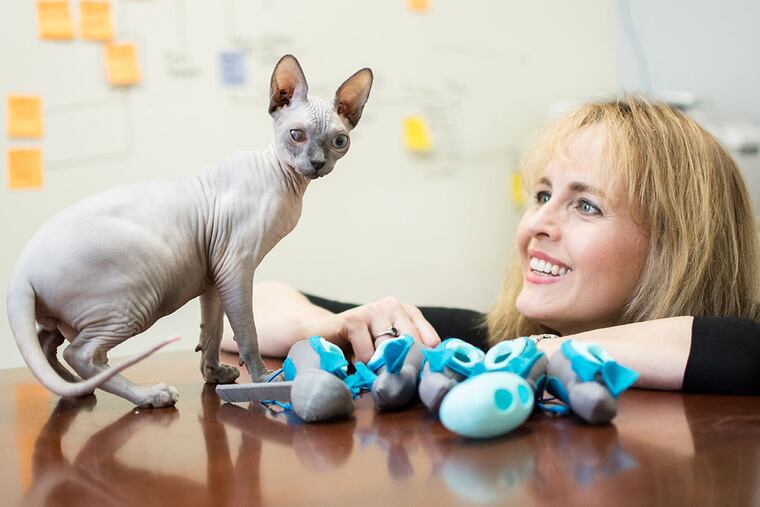An eat-and-play way to satisfy cats
Next time your cat shreds a couch cushion, lunges at your legs or barfs, blame the overly generous pour you made into his or her food bowl and the lack of any "hunting" opportunities for that pet as a prerequisite to eating.

Next time your cat shreds a couch cushion, lunges at your legs or barfs, blame the overly generous pour you made into his or her food bowl and the lack of any "hunting" opportunities for that pet as a prerequisite to eating.
Animal behaviorists, supported by extensive feline environmental-enrichment research, have been speaking of the link for at least 20 years - without influencing much change in household cat-feeding practices.
Veterinarian Liz Bales is out to change that - and make a few bucks for herself and her partners at FEED Co. in South Philadelphia.
If FEED, or Feline Environmental Enrichment Design Co., gains a substantial following - and the explosive Kickstarter debut of its NoBowl Feeding System earlier this month suggests it could - in-home cat dining is likely to become more akin to how nature intended it.
"This isn't an invention, it's a movement," Bales, 43, FEED's CEO, a self-described "catvocate" and mother of two from Chestnut Hill, said recently at the company's headquarters. It shares space with several other tenants at 1241 Carpenter Studios + Artspace, a former factory that is now the creative haven of artists and craftspeople.
The embodiment of FEED's movement is a patent-pending hollow, plastic, oval-shaped vessel measuring 4 inches by 21/2 inches. It's capable of holding 1.6 tablespoons of food and is covered with a fabric "skin" designed to resemble a mouse, minus a nose and eyes to minimize choking hazards.
A kit includes five NoBowls, to be filled each day and positioned throughout the house for a total daily feeding portion of one-half cup, the recommended amount for a healthy feline lifestyle, Bales said.
By rolling the NoBowl, a cat can release the food. The skin gives the animal something to grip so it can play with its "catch" before eating - just like it would do in the wild with, say, a real mouse or bird.
On March 10, the company launched its Kickstarter campaign to raise $36,000 to fund the making of a production mold and to get NoBowl to market.
The goal was reached in an astonishing four days, with the kits offered at $50 each. They also include a training vessel and a portion scoop. The campaign will run until April 10 at http://kck.st/1PhaP6y. By March 24, it had raised $74,144 from 1,094 backers.
"I actually could cry," Bales said. "It's just been unbelievable."
For Bales, it's the validation of an idea that occurred when she was driving home from the 2014 Atlantic Coast Veterinary Conference in Atlantic City, where she had listened to several lectures on animal behavior and the causes of it.
It reinforced what she knew from her schooling and practice about unfriendly, aggressive, lethargic cat conduct resulting from overeating. A cat's stomach can hold one to two tablespoons.
"The theory behind it is very solid," said Carlo Siracusa, a veterinary behaviorist at the University of Pennsylvania School of Veterinary Medicine who has no connection to NoBowl. He said cats with outside access eat nine to 12 small prey during the day, which amounts to "a lot of environmental stimulation" absent in a house. That void leads to acting out - and girth.
"The physiology of a cat is set for this type of feeding," Siracusa said of NoBowl. Transitioning to it should be possible for cats of any age, he said.
Just days after the conference that inspired her, Bales was at a neighbor's birthday party, also attended by inventor Steve Krupnick, 66, of Philadelphia. Although medical devices have dominated much of his 45-year career, Krupnick's creations also included the Flippy Flyer Frisbee, popular among people and dogs alike.
"What she was saying makes sense," Krupnick said of why he thought FEED was worth joining. "I get that if you take something that has a natural instinct to do [something] and you deprive them of that, it's going to manifest in some way. Cats hunt . . . and yet we deprive them of it."
FEED's other partners are Krupnick's son David and Sue Lohr, who has a background in medical education and strategy for big pharmaceutical companies, both of whom are from Philadelphia, and Phebe Kearney, an expert in product development and manufacturing from Washington Township.
They plan to have NoBowl available for purchase in the summer, with an August rollout at SuperZoo in Las Vegas, the national show for pet retailers.
215-854-2466@dmastrull